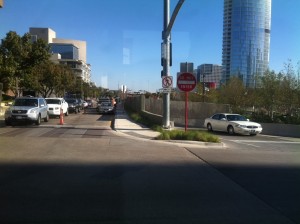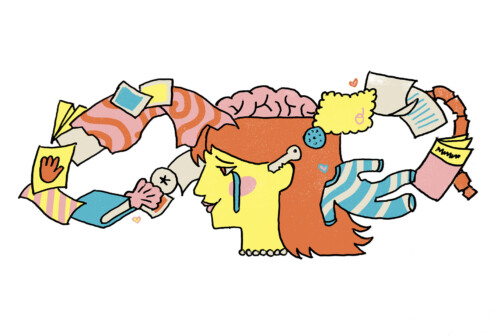(image of the two walls lining the highway exit ramp I witnessed two little kids climbing as they moved from parked car to the playground at the deck park yesterday.)
I’ve been wanting to post this for a while since it is the most succinct way/analogy I can think of to explain the nature and dynamics of cities. It involves the invisible hand (the real estate market), the invisible arm (transportation), and the invisible brain (government/policy) behind it all.
There is a direct correlation here with systems theory I often cite (as cities are little more than highly fractalized complex systems), in terms of the three primary components of complex systems: elements (the most visible and least important), connections (kinda like transportation, huh?), and purpose (it’s reason for being).
It is common when examining systems to focus on what is most tangible, the elements, because they’re the simplest to understand. It’s also how to get cities entirely wrong. This is what I call cosmetic urbanism. It confuses labels and things with the actual process of urban dynamics, morphology, and emergence, i.e. saying we need “mixed-use” without having the proper soil to cultivate into existence as the natural by-product of rational choice.
What results is potemkin villages and failed real estate deals. There are plenty of examples all over the city. Shopping sprees for jewelry buildings and bridges, nor plastic surgery of deck parks solve the underlying problems. Those lay within the invisible arm and invisible brain. The connections and purpose of the system.
And today, I got the perfect opportunity when a friend posed a question via email about the latest news that the “Horseshoe” project, a $750 million dollar highway rebuild of the downtown mixmaster, has been greenlit. It was actually more of a comment than a question, in that he mentioned the news to his significant other who was astonished when he told her that highway expansion only solves traffic temporarily and that it will inevitably become congestion.
There is no expanding our way out of the mess, because in effect (and in addition to what is written below) the intra-city highway network actually reduces overall system capacity. More streets are left empty as it fills up and the movement patterns become more regional, more highway-based. And an empty street is far more pernicious than a congested one.
But I was fascinated, not so much by her disbelief, but rather the successful of the rhetoric surrounding highway building. Listen to any transportation person. They conflate widening with “improvement.” And we assume these people are experts so we trust them. Of course, their only expertise lies in road building. The question remains, “to what end?”
Here is an edited version of my response for popular consumption (with some relevant quotes from Mumford sprinkled in):
Yes, I did see the news. Wick Allison retweeted my joke yesterday that we’re spending $750 million to “improve” this highway and move 450,000 cars per day, meanwhile Champs Elysees moves that many pedestrians per day yet THEY’RE the socialists. I went on to add that the real estate value along the two roads in relation to the infrastructure spent is probably close to inverse, ie if real estate value to infrastructural costs along Champs Elysees is 10:1 or whatever, then along [insert any highway] it’s 1:10. Over time, this ratio becomes exponential. In both directions.
Point being, of both this specific example and of transportation policy/design/funding in general, is that real estate is the invisible hand but transportation is the invisible arm that shapes it.
The simple concept is induced demand and it is pretty well understood at this point, but ignored by politicians who want to bring in “jobs” aka federal spending (because THAT’s sustainable – bringing in temporary jobs locally to move people out of your city. See: Detroit). A study from Brown University showed that for every highway that is built in a city (aka intracity as opposed to intercity, ie Autobahn) there is an 18% population loss associated to the core city. Similarly, a study from University of Toronto proved a 1 to 1 relationship in highway lane miles to average citizen vehicle miles traveled. Meaning, if you double freeway lane miles in a city over a 20 year span, the average citizen will drive double the amount. You’re driving more, thus the induced demand from the very construction of the transportation network. We’re ‘nudged’ into ‘loving our cars’ unwittingly, or what I call dependence, which isn’t really love within any metaphor.
“By pushing all forms of traffic onto high speed motor ways, we burden them with a load guaranteed to slow down peak traffic to a crawl; and if we try to correct this by multiplying motor ways, we only add to the total urban wreckage by flinging parts of the city ever farther away in a formless mass of thinly spread semi-urban tissue.”
The specific numbers aren’t as important as the implication, that as intracity highway networks grow, population settlement patterns are displaced outwards, further apart and less efficiently. Compare all of your trips for daily needs to say, somebody in Barcelona. Whose is safer? Whose is more enjoyable? Whose is shorter and more efficient thereby exerting less energy and in turn, placing less of a ‘tax’ on the citizen to meet their needs (and that’s before even getting into the actual cost of building and maintaining the infrastructure).
The reason is because highways fundamentally shift the real estate market outward, they subsidize driving (no tolls, user fees ie gas taxes cover only half the cost, artificially deflated gas prices) as well as real estate onto ever cheaper (further out) land by making driving temporarily easier. Then everybody moves further out and the roads fill up as more and more people are driving more and further. They’re effectively ‘induced’ into it. That’s only one half of the equation, the other half is that freeways deflate real estate values along them because they’re unsafe, noisy, smelly, and disconnective to local movement patterns. The highest and best use is parking lots, gas stations, and drive thrus.
“Under the present suburban regime, every urban function follows the example of the motor road; it devours space and consumes time with increasing friction and frustration, while, under the plausible pretext of increasing the range of speed and communication, it actually obstructs it and denies the possibility of easy meetings and encounters by scattering the fragments of a city at random over a whole region.”
Intracity highways take land outside of town that has a value of 1 and makes it a 2. There is a profit margin for developers, but comes at a steep price to taxpayers by way of infrastructure to dispersed population. On the other hand, it takes in town land that has a value of 10 and similarly transforms it into a 2, disinvestment. See virtually every downtown in America. And to bring our downtown’s “back” we’re heavily subsidizing any and every magic bullet we can think of, until finally settling on the right one, which is to bring people back, residential, by also heavily subsidizing it. But that did nothing for the actual demand equation which is still at a 2. If there isn’t a profit in it (as the public’s ability to subsidize infill diminishes), infill development, ie urbanism, won’t be the modus operandi for the real estate market.
“For when one conquers space one also increases the populations to whom that distant space is accessible. The prospective net gain is considerably less than zero.”
Deflate the core, inflate the bleeding edge and you get sprawl. Nearly everything else related to sprawl is irrelevant and an outgrowth of this fundamental problem (which we aren’t treating). Until we get the policy directives straightened out governing the invisible arm, we’ll never have sustainable, enjoyable, empowering cities that are engines of economic opportunity (for everyone), improved quality of life (for everyone), and conveyor belts of civilization advancement. And that means getting the invisible brain controlling the invisible arm on the right path. What’s the point of government? What’s the point of cities? At present, the only discernible direction seems to be wanton and profligate spending that devalues cities, which are the greatest achievement and invention of humankind.
“Human purpose should govern the choice of the means of transportation. That is why we need a better transportation system, not just more highways.”
I’d like to think the point of government and in turn cities follows closely with Maslow’s hierarchy of needs, so 1) safety, both short (not dying in car crashes) and long- (not embroiled in wars over oil) term, and 2) maximum economic development and opportunity for all in order to improve quality of life at minimal expense and infrastructure. Why spend money on highways when they don’t fundamentally alter the demand equation driven by human need, but instead only how they move between the various day to day origins and destinations? Instead, we can spend on things like education, healthcare, etc. But those are my biases. The political process, of an educated body politic ideally could figure out what they want. Which brings me back to the original point, how do we want our cities to be defined? What do we want to expend public coffers towards? Expensive highways lined with chuck e cheese’s, triple x drive thrus, and gas stations? Or, Walkable boulevards lined with highest real estate value in the world (which is simply a product of demand, desirability).
*Mumford wrote the book I’m quoting from more than fifty years ago. They still apply today because he saw the pattern, the inevitability of the system at work, rather than focusing on the elements or details (though he used those elements to draw the picture).







